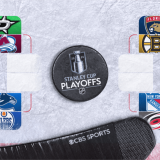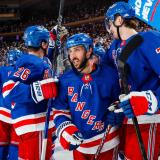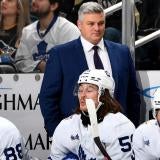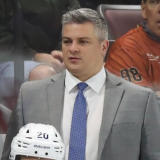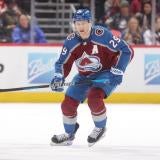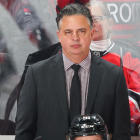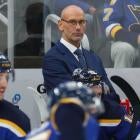
More NHL Offseason: NHL rumors | Rumor mill | Trade Tracker | 2014-15 preseason odds
In the salary cap era, where NHL teams have to be efficient with their money, it's important for each club to have a core group of players who set the foundation on which to build the rest of the team. This group often includes the players who consume the bulk of a team's cap space, while also providing the greatest on-ice impact.
With that in mind, Eye on Hockey introduces our summer series: "Core Values." We'll take the rest of summer to evaluate the group of five to seven players who make up the core of each team. Using criteria like point production, average age, how the players were acquired, total cost and cap hit, we'll detail which teams have the strongest cores and which need work. On top of that, we'll also gaze into the future to look at the players who could one day be part of this crucial group for each team.
The Philadelphia Flyers were one of the more intriguing teams to follow during the 2013-14 season. The club overcame a disastrous start and ended up making the playoffs before a first-round ouster at the hands of eventual Eastern Conference champion New York Rangers.
There was a regime change over the summer with Paul Holmgren getting "promoted" away from day-to-day duties as GM, making way for franchise favorite Ron Hextall to take over that job.
Hextall has been a bit hamstrung out of the gates, however. There are bad contracts all over this roster, some that could prove costly over multiple years even as the salary cap rises. What makes the Flyers particularly interesting is the fact that the core we’ve identified for the team doesn’t make all that much relative to other teams. Part of that is due to the youth of a few of the players, but it also signifies where the trouble could lie for this organization going forward.
Now the club has to deal with the unexpected and likely long-term loss of Kimmo Timonen on defense, which makes a problem spot for the club a bigger problem.
Make no mistake, despite questionable structure under the salary cap, the Flyers have talent in the lineup and it all starts at the top with Claude Giroux. The team's star is in a class of own, which gives the team a true centerpiece to build around.
Here's who they're surrounding him with now.
Core Values: Philadelphia Flyers
Players (Age, term remaining on contract): C Claude Giroux (26, 8 years), RW Jakub Voracek (24, 2 years), RW Wayne Simmonds (25, 5 years), C/W Brayden Schenn (22, 2 years), C Sean Couturier (21, 2 years), D Braydon Coburn (29, 2 years), Andrew MacDonald (27, 5 years)
Total cap hit for 2014-15: $30,250,000 (43% of cap space consumed by seven players)
Average Age: 24.8
Total point production in 2013-14: 118 goals, 191 assists 309 points (48.6% of team's total point production)
Philadelphia Flyers Player Usage Chart via ExtraSkater.com*:

*Circle size represents time on ice, shade of circle represents possession (5v5 Corsi For percentage -- total shot attempts for relative to total shot attempts against). Blue represents CF percentage of 50 or better. Red represents below 50 percent. The darker the shade, the further away from 50 percent. Side note: Simmonds’ circle is hiding behind Lecavalier, while Andrew MacDonald did not meet the 41-game threshold with the team for inclusion on the chart.
About the Core
Claude Giroux: There’s a good case that could be made that the Flyers’ core is Giroux and Giroux alone. He’s a cut far above the rest of the roster and showed last year that he can put the team on his back when he needs to. A Hart Trophy finalist in 2013-14, Giroux has 377 points in 415 career games in Philly. He has been durable, productive and is now the team’s captain. The team built around him is where things start to get dicey. Right now, the Flyers simply don’t have the pieces to compete for a Stanley Cup, but they have their centerpiece in Giroux. Over the last two 82-game seasons, Giroux has put up 179 points including 56 goals. He was also a point-per-game player in the lockout-shortened season. This is a guy striding into his prime and if the team doesn’t get him more help throughout the lineup, it's going to be wasted. How he was acquired: 2006 NHL Entry Draft, first round, 22nd overall
Jakub Voracek: Coming off of a career year in 2013-14 and having had 46 points in 48 games the season before, Voracek has shown just how much value he brings to the Flyers offensively. Though he hasn’t replaced the goal scoring of Jeff Carter, for whom Voracek was traded to Philadelphia, he has become one of the team’s top producers. The good news is that the former Blue Jackets first-round pick is only 24 and is really starting to surge in his career. The best is likely yet to come. Since arriving in Philadelphia, Voracek has posted a 0.75 points-per-game average with 157 points in 208 games. He should expect a decent raise when his contract is up after the 2015-16 season, which could force the Flyers into some more salary maneuvering. How he was acquired: Traded from the Columbus Blue Jackets with a first- and third-round pick for Jeff Carter on June 23, 2011

Wayne Simmonds: For all the criticism the Flyers deservedly get for the contracts they’ve handed out, the deal Simmonds is currently playing on is one of the league’s most valuable. With a cap hit just under $4 million, Simmonds’ performance exceeded the value of his contract in a big way. He hit 60 points for the first time in his career, posted a career-best 29 goals and was the grind-it-out forward NHL teams still adore. He's another of the Flyers players that appears to be surging into his prime and the Flyers still have him under contract at a relatively cheap rate for five more years. With his goals-per-game taking off (0.34) in the three years he’s been with the Flyers, Simmonds affords the team a bona fide top-six threat who keeps other teams honest with offense and his physical game at a cap-friendly value. How he was acquired: Traded from the Los Angeles Kings with Brayden Schenn and a second-round pick for Mike Richards and the rights to Rob Bordson on June 23, 2011
Brayden Schenn:The Flyers have seemingly put a lot of faith in Schenn after acquiring him as part of the Mike Richards trade with the Los Angeles Kings. He put up his first 20-goal season with the club in his first full 82-game campaign, but continually moving forward in his development is going to be a big key for the organization. There’s still a lot left to figure out about Schenn who has appeared in 192 NHL games, all but nine of which have come in a Flyers uniform. He’s been a full-time NHLer for three years now and the results are only just beginning to show. He’s only 22 years old and on a cheap deal that could provide the Flyers an incredible return and perhaps force a long-term offer after his bridge deal is up after 2015-16. There’s a place for him in the team’s top six with Scott Hartnell gone. Schenn has to be able to seize that role and not let it go to help the Flyers stay a playoff contender this year and beyond. How he was acquired: Traded from the Los Angeles Kings with Wayne Simmonds and a second-round pick for Mike Richards and the rights to Rob Bordson on June 23, 2011
Sean Couturier: It’s not often you see a player taken in the top-10 at the draft almost immediately converted to a defense-first center, but that’s essentially what happened with former eighth overall pick Couturier. The good news for the Flyers is that he’s doing pretty well in that role. His possession numbers were not great last season as the usage chart above shows, but a lot was asked of him last year. He saw the bulk of his shifts start in the defensive zone and played 19-plus minutes a game, often receiving some of the toughest matchups. And this is key: he’s 21 years old. That’s big time faith in a player of his youth and he’s answered that call pretty well. Couturier had a career year offensively with 39 points in 82 games including 13 goals. Additionally, Couturier put 165 shots on net last season, so the offensive side is starting to poke through even more. He’s growing into a better all-around player and will continue to play a valuable role on this team. Couturier is on a cheap bridge deal right now, too, so he should bring some tremendous value over the next two years to the Flyers. How he was acquired: 2011 NHL Entry Draft, first round, eighth overall
Braydon Coburn: The team’s No. 1 defenseman, Coburn is not noted as a superstar player, but he has been putting together solid seasons while taking on some of the toughest competition opponents have to offer. As you can see from the usage chart above, he’s surviving pretty well despite being asked to do a lot. He led the team with an average of 22:26 per game and even with his heavy defensive usage, the team posted better possession with him on the ice. That makes it somewhat curious that Coburn has been included so often in trade rumors, but that might have to do with the team’s log-jam of big contracts on defense. Considering Coburn is making $4.5 million over each of the next two years, the value he provides exceeds that of most of his fellow blueliners. He’s not going to wow anybody with offense and his defense is probably best described as adequate, but he makes the Flyers better when he's on the ice. How he was acquired: Traded from the Atlanta Thrashers for Alexei Shitnik on February 24, 2007
Andrew MacDonald: As noted above, MacDonald's inclusion is triggered more by what the team thinks of him and the faith they’ve put in him with a five-year, $25 million contract. A gifted shot blocker and strong defender, MacDonald certainly brings value to the team, but it is going to be extremely difficult for him to bring $5 million-a-season worth of value. Though not included on the usage chart above, MacDonald was utilized in shutdown situations by the Flyers after he was traded from the New York Islanders. He had four assists in 19 games after the trade and his possession numbers were not great. In fact, they’ve never been great. His teams are often getting badly out-possessed when MacDonald is on the ice. The veteran rearguard did have 28 points last season between the two clubs, which marked a career best and he logged a ton of ice time. With Timonen out, the Flyers are probably going to lean heavily on MacDonald as a top-four defenseman. Considering before last season he never made more than a million dollars in a season, the massive pay jump was kind of shocking. The Flyers have bet big on MacDonald, now he has to deliver with pristine defense. How he was acquired: Traded from the New York Islanders for Matt Mangene, a third- and second-round pick.
Who’s next in line

The Flyers don’t have a ton in the prospect pipeline at forward right now. Scott Laughton, who had a great final season in the OHL last year with 87 points, is likely the most pro-ready of their forward prospect pool. He saw five games of action in the 2012-13 season, but has been left to get more reps in junior hockey, which was absolutely the right move. He has potential and could be a big piece going forward.
The Flyers have built an interesting pipeline on defense, which is exactly what they need with how expensive their blue line has gotten. The Flyers boast one of the stars of last year’s college hockey season in Shayne Gostisbehere, who is now under pro contract after helping Union College win the national title. He could be the puck-mover this blue line will need after Streit’s career wraps up, if not sooner.
Swedish defender Rober Hagg also is a promising rearguard who could push for an NHL spot soon. Additionally, there's a lot of time for first-rounders Samuel Morin and Travis Sanheim to develop into top-end defenders.
More immediate however, is goalie Steve Mason, who is only 26, but an NHL veteran. He’s been the team’s No. 1 for the last season and was handed a three-year extension. Mason showed a lot of promise that he’s rebuilding his career after never being able to live up to his Calder Trophy campaign in Columbus. He was inconsistent last season, however, hence the trepidation in adding him to the core. Mason has to be excellent for the Flyers, however, if they’re going to stand a chance next season.
If Mason does falter, the team might be counting the minutes until promising goaltending prospect Anthony Stolarz is ready for the NHL. The 6-foot-6 monster between the pipes has put together a really strong junior career with the London Knights of the OHL.
Overview
There’s really nothing conventional about the Flyers and the lineup is kind of a mixed bag, but there's talent there to put something together.
One of the stranger things about this club, however, is that there are more expensive players outside of the core group than in, which isn’t usually a good thing.
That said, the Flyers will have to hope for a bounce-back year from Vincent Lecavalier, if he’s not somehow traded first, and will hope that offseason acquisition R.J. Umberger benefits from his return to Philly. Those are veterans who are going to have to give a lot due to the money they’re making and terms remaining on their deals.
The team has other valuable players from outside the core like Mark Streit, who finished fourth on the team in scoring last year from the blue line, and Matt Read, who has been a reliable producer on the wing. They should continue to provide what they did last season.
Unlike other cores we’ve covered so far, however, there’s a significant drop off after the top player. Giroux is on a tier all his own with this team. The second tier includes the likes of Simmonds and Voracek, while the rest of the group is probably a tier below them as well either due to youth or questions about their long-term viability.
That leads to a lot of questions in the long-term and is going to put some pressure on the Flyers to get the most out of the prospects they already have in the system. They’ll need those players playing on cheap entry-level deals in the not so distant future. That can help mitigate some of the bad money floating around the roster.
So what does any of this mean for 2014-15?
The Flyers still have a team capable of making the playoffs. After all, they did it last year with largely the same team. They’ll have key youngsters like Brayden Schenn and Sean Couturier with another strong year of development under their belts. They kind of have to hope Mason comes through with another season with a save percentage above the league average, with a little more consistency as well. The Flyers will also need that defense to step up.
When it comes to a championship-caliber club, that’s where the Flyers are currently falling short. It has been almost 40 years since the club's last Stanley Cup, and if fans are getting impatient, it's warranted.
The one thing Hextall is going to have to do in his new job is show that he has a long-term vision for this club. There can't be many shortcuts taken via free agency or big trades. It hasn't worked and in today's NHL, it probably won't work. There's a lot for the new GM to do and none of it is terribly easy, but at least he has a place to start.







